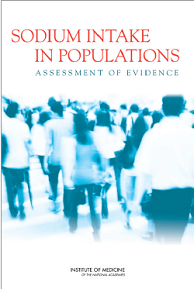Sodium and the National Academies of Science (NAS) Health and Medical Division (HMD)

The National Academies of Science (NAS) Health and Medical Division (HMD), formerly the Institute of Medicine (IOM), is an independent, nonprofit organization that works outside of the government to provide unbiased, dependable advice to decision makers and the public. The HMD’s goal is to help those in government and the private sector make informed health decisions by providing evidence they can rely on. Many of the studies that the HMD undertakes begin as specific requests from Congress, federal agencies, or independent organizations.
The IOM has published two reports directly related to sodium and the HMD is preparing for a review of the DRIs for sodium and potassium.
DRIs for Sodium and Potassium
In preparation for an anticipated review of the Dietary Reference Intakes (DRI) for sodium and potassium, a systematic evidence review of sodium and potassium began in late summer 2016. The evidence report is expected to be completed by fall 2017.
Discussions are underway with the National Academies of Science, Engineering, and Medicine for a DRI review of sodium and potassium. The proposed review would begin in fall 2017 and draw on the guiding principles for chronic disease endpoints and the systematic evidence review.
Stay tuned for additional updates as these projects develop.
For more information please visit the ODPHP DRI Activities website.

2013 Institute of Medicine Report Supports Efforts to Reduce Sodium Intake
The IOM report, Sodium Intake in Populations: Assessment of Evidence, focused on studies evaluating the relationship between sodium intake and health published since 2003. Instead of looking at measures such as blood pressure, the researchers assessed the relationship between sodium and other health outcomes, including strokes, deaths from cardiovascular disease, and heart failure, among others.
The IOM committee reported that the evidence showed a relationship between higher levels of sodium consumption and risk for cardiovascular disease. It also concluded that there is substantial population benefit—and no evidence of harm—from reducing sodium intake to a level of 2,300 milligrams (mg) per day. However, because Americans eat an average of 3,400 mg per day, it is clear that public health efforts need to continue to encourage lower sodium intake.
For CDC, sodium reduction continues to be a priority. Reducing sodium intake is a critical, achievable, and effective public health action to reduce blood pressure and improve cardiovascular health.
Visit the Health and Medical Division Website for more information about this IOM report.
Read CDC’s commentary on the 2013 IOM report in the American Journal of Hypertension.
Read the IOM committee’s clarification in JAMA about the 2013 report’s conclusions. (Subscription or payment required.)
2010 Institute of Medicine Report Finds Coordinated Action Is Required to Reduce Sodium
The 2010 IOM report, Strategies to Reduce Sodium Intake in the United States, concluded that government, industry, community groups, and consumers must work together to reduce sodium content in the food supply. The report recommended as a main strategy that the U.S. Food and Drug Administration set mandatory national standards to gradually reduce sodium content in foods.
National standards would lead to lower sodium levels of food in stores and restaurants, helping consumers to reduce their personal sodium intake.
Visit the Health and Medical Division Website for more information about this IOM report.
- Page last reviewed: August 18, 2017
- Page last updated: August 18, 2017
- Content source:



 ShareCompartir
ShareCompartir